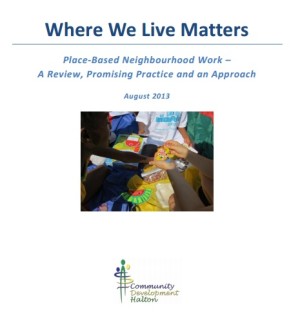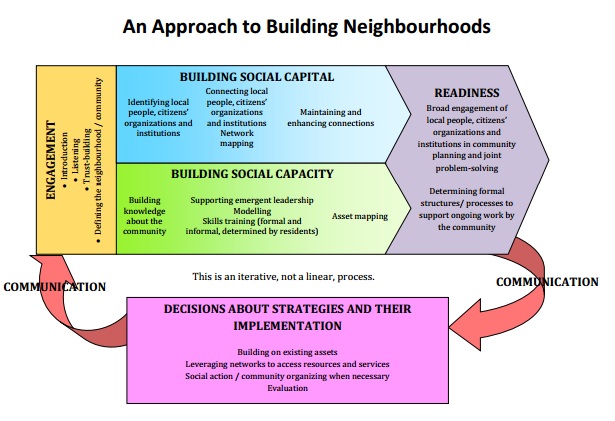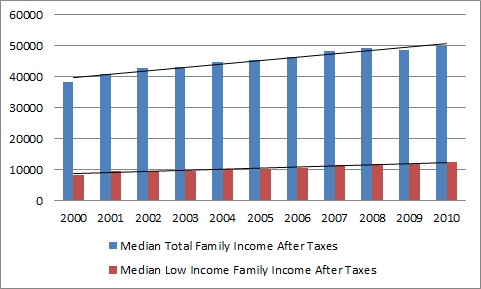Posts Tagged ‘poverty reduction’
Posted on: January 8th, 2014 by Waterloo Region Crime Prevention Council
 Title: Where We Live Matters | Place-based neighbourhood work – A review, promising practice and an approach
Title: Where We Live Matters | Place-based neighbourhood work – A review, promising practice and an approach
Authors: Jody Orr and staff of Community Development Halton
This new publication from Community Development Halton is a comprehensive read for any community development animator who works directly in neighbourhoods. Recognizing that the landscape of community work has changed dramatically in the past two decades, Orr and her associates urge us to adapt our approaches with the changing needs of our communities. And in case you’ve missed it, communities have changed!
This 70 page publication makes the case for ‘place-based neighbourhood work’ and details an engagement framework (pictured below) – An Approach to Building Neighbourhoods. Community work never follows a linear process and “Where We Live Matters” recognizes that neighbourhoods operate in a cyclical, repeated fashion between all stages of the engagement process depending on the issue or situation and the people involved in the work. It’s messy, chaotic and creative work and it’s hard to capture it accurately on paper!

What I like about the model (pictured above) is that they break down the engagement process into more manageable building blocks. I can’t recall ever seeing ‘readiness’ so prominently placed in an engagement process – we all know it’s necessary – so glad to see it named in plain language. I think the distinction between social capital and social capacity is important. Too often, they are used interchangeably, but they truly are distinct concepts in community building.
The remainder of the article outlines:
- the key characteristics of communities in which effective community building processes have been carried out,
- the personal and professional qualities and skills of the people involved in effective neighbourhood work
- best and promising practices in neighbourhood work, focusing on place-based activity
- a brief history of place-based neighbourhood work
When you read the brief history of place-based work (Appendix 1), it’s easy to see how far community work has strayed from the direct neighbourhood level. “Where We Live Matters” urges a shift from the universal, service delivery approaches of the past decades, revisiting the classic community development approach of place-based work. There’s no denying it; there are unique and pressing needs in specific geographic areas of every city, town and municipality. Try as we might, universal approaches will never reach the most vulnerable neighbourhoods in our communities. The work needs to be done where it matters most – in neighbourhoods where people live, and with people who live there.
There’s a subtext to this article that is hard to ignore. It speaks to the role of traditional service delivery institutions, large systems and government social policy. Essentially… these entities are too slow and inflexible enough to respond to the needs of neighbourhoods. Often, these systems and institutions are so policy bound that they actually become an obstacle for the communities they are designed to be helping. Which reminds me of so many stories from the very wise Jim Diers who claims that government and large agencies are often the greatest stumbling block for neighbourhoods and communities.
Isn’t that upside down?
As a community practitioner and animator myself, it’s always refreshing to come across good applied research and this one is solidly rooted in practice and the experience of people working effectively with neighourhoods. The authors draw on the work of pioneers of community work such as:
- Joh McKnight
- John Kretzman
- Bill Lee
- Margaret Wheatley
- Paul Mattessich, Barbara Monsey & Corinna Roy
“Where we live matters” is not new earth-shaking work, but resonates with my own community work as an animator and echoes the growing plethora of place-based initiatives such as:
To better understand the document, check out this Tamarack podcast with Joey Edwardh, Jody Orr and Rishia Burke of Community Development Halton. They lead you through this resource document including an exploration of what inspired the investigation, the important role of an “animator” who enlivens and encourages development in community, funding for work that is hard to measure, and more!
After reading “Where we live matters” I wanted to go pull the McKnight, Kretzman, Lee and Wheatley books from the bookshelf and get reacquainted with the foundations of place-based work. There’s inspiration to be found for our daily work.
But most importantly, “Where we live matters” reminds us that what goes on in our neighbourhoods and the quality of life there has the greatest impact on our quality of daily living. We absolutely should be investing in neighbourhoods.
Posted on: December 31st, 2013 by Waterloo Region Crime Prevention Council
I just love this time of January when you get to take a look back at what’s been accomplished over the past year, ponder what worked well and scratch your head about what emerged that you never expected.
As we turn the page into 2014, I also love the tradition of digging into our blog to find what you, the readers, found most interesting over the last year. With over 45 blog posts in 2013, there was certainly something for everyone. We had 23 different guest bloggers contribute community responses on the root causes of crime as part of the Snapshot in Time: Root Causes of Crime in Waterloo Region. You can find all the posts and community responses in one tidy corner of the blog.
But, our readers are diverse which indicates why our most popular blogs on Smart on Crime ranged from book reviews to casinos and from guest commentary to provincial budget analysis. Here’s the round up of our top 13 posts from 2013.
1. The local impact of youth unemployment/underemployment – guest post by Carol Simpson
“If youth in the labour market cannot find employment, they find it increasingly difficult to become established in the “adult” world. They have done nothing wrong. They have done what they were told to do and were supposed to do yet cannot find that suitable connection to the workforce. This impacts their confidence and their ability to “fit in”. Many have chosen to give up and have simply walked away from the labour market making it even harder to find their “place” in the world. This results in frustration and anger and they feel neglected.”
2. What we’re reading: Rescuing Policy – by Anthony Piscitelli
“How can government solve the complex issues facing society?”
3. Children in care in Waterloo Region: Compounding risk for vulnerable children – by Jill Stoddart
“Children living in the care of the child welfare system have a higher likelihood of justice system involvement in comparison to children living with their biological parents”.
4. Excuse me Waterloo Region, your homelessness is showing – by Lynn Macaulay
“I feel part of a sector where I join in solidarity with people experiencing homelessness and many community members who together stand up to say – people who are homeless matter. We collectively are committed to ending homelessness in Waterloo Region. This is a lofty goal, which will take much persistence and hard work, but with the determination and skills of this community, I believe it is possible.”
5. Income of low income families: Root cause of crime in Waterloo Region – by Anthony Piscitelli
Neighbourhoods that are at an economic disadvantage when compared to other areas report higher crime rates. In addition, societies where wealth is concentrated amongst a small group of individuals report higher crime rates.
6. Through the eyes of crime prevention: Ontario 2013 Budget – prepared by Alexadra Kraushaar

7. The day I went to prison – by Andrew Jackson
“Five minutes later I stood at the front of a classroom with 25 women waiting for me to start talking. “Good morning” I said. “Good morning.” came the reply from the women of Grand Valley Institution for Women (GVI).”
8. Knowing other people care: The importance of community to women who have experienced homelessness – by Elizabeth Clarke
“It goes almost without saying that the overarching cause of homelessness is poverty, but not all people who are poor become homeless. Not all people who become homeless stay that way for long.”
9. Waterloo Region’s Catholic Schools: Laying a solid foundation for student success – by David DeSantis
“It is no surprise that the length of involvement in schooling significantly impacts participation in criminal activity and the probability of incarceration, as found in Snapshot in Time: Root Causes of Crime in Waterloo Region. In fact, this has been well-known in the education sector for many years – which explains the great lengths to which school boards go in mitigating against this problem.”
10. 7 things we learned from Alan Quarry about social media for social change – by Juanita Metzger
“Creating change that lasts happens in relationships, from one person to another, and these days, often facilitated with the power of social media. Here are Alan’s 7 best thoughts on the principles for engaging people in change.”
11. A Snapshot in Time: The Root Causes of Crime in Waterloo Region – by Anthony Piscitelli
“The Waterloo Region Crime Prevention Council believes monitoring the root causes of crime can aid the community in addressing crime, victimization and fear of crime through awareness, discussion, leadership and action. Once the root causes are understood more clearly, resources can be applied to areas where the community is doing poorly. A Snapshot in Time: The Root Causes of Crime in Waterloo Region identifies the root causes of crime right here in Waterloo Region and provides a tool to aid local policy makers in targeting interventions to where they are most needed and where they can have the greatest impact.”
12. Poverty in Waterloo Region… Is that REALLY OK with you? – by Mary MacKeigan
“The data in the section of Root Causes of Crime in Waterloo Region titled Income of Low Income Families is no surprise to those of us who are familiar with poverty-related issues in our regional community. In fact, in Waterloo Region, 36 earners make more than $2.57M; 360 make more than $685K; 3,610 (the top 1%) make more than $396K. Individuals who make more than $81,200 are in the top 10%. On the other hand, the median income of the bottom 50% is $14,100!* In 2007, one third of employed individuals were earning $14.00/hour or less. This is poor – it may not be deep (or absolute) poverty, but it is precariously close to it. “
13. What are the odds? The vulnerable child of today as the problem gambler of tomorrow – by Chris Sadeler
“The official position statement of the Waterloo Region Crime Prevention Council given at a public consultation on the question of a casino in the City of Kitchener. The remarks were given by WRCPC Executive Director, Christiane Sadeler on behalf of the Waterloo Region Crime Prevention Council.”
So many great reads from 2013. But if you’re in the mood for something to watch, rather than read, might I suggest our personal favourite, “Won’t you be my neighbour?” Who can resist Anthony Piscitelli’s homage to Mr. Rogers!
We look forward to bringing more great smart on crime blogs for you to ponder. Better yet, we love hearing your comments, reactions and responses to the posts and guest commentaries. We look forward to hearing more from you in 2014!
Posted on: June 28th, 2013 by Waterloo Region Crime Prevention Council
The data in the section of Root Causes of Crime in Waterloo Region titled Income of Low Income Families is no surprise to those of us who are familiar with poverty-related issues in our regional community. In fact, in Waterloo Region, 36 earners make more than $2.57M; 360 make more than $685K; 3,610 (the top 1%) make more than $396K. Individuals who make more than $81,200 are in the top 10%. On the other hand, the median income of the bottom 50% is $14,100!* In 2007, one third of employed individuals were earning $14.00/hour or less. This is poor – it may not be deep (or absolute) poverty, but it is precariously close to it.
Another point I’d like to make has to do with the title: ‘Income for Low Income Families’. I’m concerned that when we (government, media and community groups) use only the word ‘family’ or ‘children’ in our communications about poverty, we further stigmatize the ‘individual’. By leaving out the word ‘individual’ are we not practicing a type of exclusion even as we talk about and promote inclusion? Now, I know that the use of the word ‘individual’ in conjunction with poverty has greater stigma attached to it than the word ‘family’ or ‘children’ and most likely this is why many of us omit the ‘i’ word. But is this REALLY okay with you?
This brings me to the issue that is – in my opinion – the root of all root causes and needs the highest priority in order to significantly reduce and prevent poverty in the long term – this is the stigmatization of people living in poverty. Societal attitudes/values impact our political voting choices and influence policy decisions. It’s my belief that if enough of us TRULY believed that everyone was a valuable member of society, we’d have much better policies in place reflecting that belief.
Since 2007, as resources allow, Opportunities Waterloo Region has been working on an initiative to shift societal attitudes towards people living in poverty. As a result of the early work completed by partners from across Canada, a three-phase strategy was developed. The three steps are:
-
research deep-seated attitudes of Canadians towards people living in poverty,
-
research best practices, and
-
develop a comprehensive, long-term multi-faceted approach to shift these attitudes.
The research step is critical. We think we know what the attitudes are, but these might be ones that are only visible on the surface. We need to know what the deep-seated societal attitudes are and how (or if) they connect to one another, so that we can create an effective communications strategy. Lofty goal? Big job? You bet!
This project stalled because we could not find the research dollars to begin the first step. Then in 2011, as a result of Opportunities Waterloo Region’s long-term partnership with Dr. Terry Mitchell, Associate Professor, Psychology at Wilfrid Laurier University, we were able to begin a project to research deep-seated societal attitudes towards people living in poverty. Some of the data collected over the two years was analyzed, the results of which was presented at the May 28th Community Conversations Series event. You can view the presentation here. The findings were discussed and ideas for next steps considered. A fact sheet is currently being developed and will be share in our September newsletter.
If you’d like a copy of the fact sheet or further information about the research project, please let me know. Although we don’t have all the answers yet, progress has been made, various strategies to shift attitudes are being discussed, and we are having deeper conversations about these attitudes – all very important early steps.
The research will continue in 2013-2014. Stay tuned for updates as they develop by reading about this project on our website.
*Data analysis by Ernie Ginsler using Statistics Canada Data, 2010.
Author: Since 2004, Mary MacKeigan has been the Executive Director of Opportunities Waterloo Region, a non-profit organization dedicated to the prevention and reduction of poverty. She has more than 20 years of experience in the field of poverty prevention, reduction and alleviation.
Posted on: June 27th, 2013 by Waterloo Region Crime Prevention Council
Over the next ten weeks stay tuned here to the blog discussion on The Root Causes of Crime in Waterloo Region where community leaders, community residents and leading experts across Waterloo Region weigh in on the root causes of crime outlined in the report.
Income of Low Income Families
Neighbourhoods that are at an economic disadvantage when compared to other areas report higher crime rates. In addition, societies where wealth is concentrated amongst a small group of individuals report higher crime rates. The graph below shows the average income of individuals in the Kitchener-Cambridge-Waterloo CMA and compares it to the average income of low income individuals in this area. This chart tracks the gap between low income individuals and those with significantly better economic means.
 Source Date: Statistics Canada, CANSIM Table 111-0015 (Released Annually)
Source Date: Statistics Canada, CANSIM Table 111-0015 (Released Annually)
The Statistics
The gap between low income families and the middle income families is growing in the Kitchener-Cambridge-Waterloo CMA. This gap is largely the by-product of stagnant incomes for low income individuals. This growth disparity in the distribution of income suggests low income families in Waterloo Region are not benefiting equally from economic growth.
Read the Community Responses
 Title: Where We Live Matters | Place-based neighbourhood work – A review, promising practice and an approach
Title: Where We Live Matters | Place-based neighbourhood work – A review, promising practice and an approach


 Source Date:
Source Date: